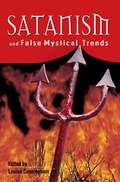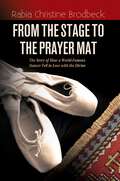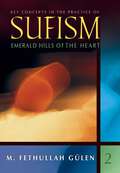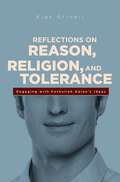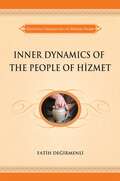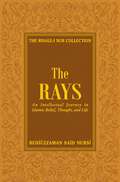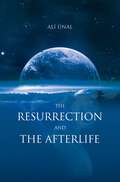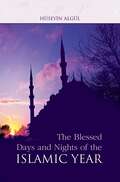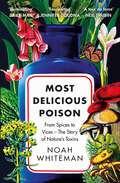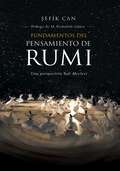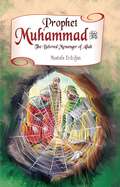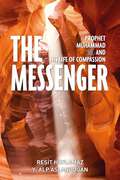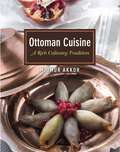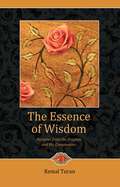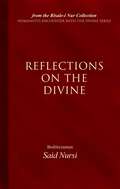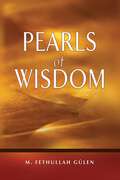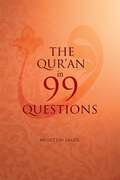- Table View
- List View
Satanism And False Mystical Trends
by Louise CunninghamSatanism, the main subject of this book, is the name for the so-called worship of Satan. The Book presents a grim example of movements that have emerged as a result of the weakened moral codes of society.
From The Stage To The Prayer Mat
by Rabia Christine BrodbeckGracefully chronicling one Western woman's attraction to the universal charm of Islam and the Prophet Muhammad, this inspirational memoir chronicles why and how Brodbeck journeyed from the exciting world of modern dance in New York City to Istanbul, where she lovingly embraced Islam.
Emerald Hills of the Heart: Key Concepts in the Practice of Sufism
by M. Fethullah GülenThis book is the second volume of the Emerald Hills of the Heart series, which brings out a comprehensive and unique examination of concepts and terms associated with Sufism in Islam. In this volume, Gulen looks at fifty different concepts. With an introduction to the heart and some of its dynamics, this work is a rich addition with more gates into spirituality. Concepts examined include freedom, altruism, wisdom, sainthood, intoxication and sobriety, wakefulness, and the universal man.
I Want Everything
by Dominic AmerenaIt starts with a lie. One small lie to get everything he wants. But one lie leads to another, and another. Caught in his own web of deception, how can he recognise the truth? And what is it going to cost him? The legendary career of reclusive cult author Brenda Shales remains one of Australia&’s last unsolved literary mysteries. Her books took the world by storm before she disappeared from the public eye after a mysterious plagiarism case. But when an ambitious young writer stumbles across Brenda at a Melbourne pool, he realises the scoop of a lifetime is floating in front of him: the truth behind why she vanished without a trace. The only problem? He must pretend to be someone he&’s not to trick the story out of her. One innocent lie leads to a slew that are definitively not, as Brenda reveals the strange and troubling truth of where her books came from. Yet the more the author unravels about Brenda&’s past, the more he begins to question whether Brenda is a reliable narrator. Is she spilling secrets or spinning tales? Is she, like him, little more than a talented thief? To write the book that will make his name, he must balance his ethics and ambition and decide what he&’s willing to sacrifice to become the next great Australian writer. This astonishing debut, full of delicious twists and wicked insights, is a dazzling novel of desire and deception, authorship and authenticity, and the costs of creative ambition. 'A brilliant concept, brilliantly executed.' Bri Lee 'That rare thing, a great contemporary novel.' Lauren Oyler &‘It's rare for a writer to be this good both at crafting a sentence and at making you want to read the next one.&’ Naoise Dolan &‘I Want Everything is a book about literature that feels like a bank heist. I loved it!&’ Rita Bullwinkel &‘A dazzling debut … I Want Everything is a playful, delicious tale of deception that speaks to the human cost of fulfilling naked ambition.&’ The Guardian &‘The hype around I Want Everything is richly deserved. This is not just a hot debut novel, but a modern Australian classic …&’ The Australian &‘A sharp-tongued literary caper, all pith and vinegar … Amerena dares us to giggle while he rubs salt into the Ozlit wounds&’ The Monthly &‘A twisty, faced-paced narrative and deftly playful language …&’ ArtsHub &‘A tantalising debut … Delectably deceptive and metafictive&’ Books + Publishing
Reflections on Reason, Religion, and Tolerance: Engaging with Fethullah Gulen's Ideas
by Klass GrinellThis is an attempt to reflect on Islam as it appears in the context of Fethullah Gulen's teachings, an influential Turkish-Muslim scholar who inspired a movement of education and interfaith dialogue. Grinell's extensive study of Islam and of Gulen allows him to pinpoint a unique expression of values and beliefs that could alter the typical understanding of Islam and Muslims in the West. He draws upon his previous studies of the Gulen Movement and comparatively places Gulen in a wider context of faith and society. What is the concept of knowledge in Islam as understood by Gulen? How is faith and service to people connected? Is Gulen after building a sultanate? Does the Gulen movement have a (hidden) political agenda? How traditional or modern is Gulen? These are some of the questions Grinell attempts to answer from his perspective. As a humanistic researcher on Islam, Grinell believes we definitely have something to learn from Islam.
A Contemporary Renaissance: Gulen's Philosophy for a Global Revival of Civilization
by Sulayman AshratiAshrati's book is a study of intellectual framework laid out by Fethullah Gulen in his call for the revival of humanity's changing power. Gulen, a prominent scholar of Islam and a social activist, is the inspiration behind the global network of education, charity and interfaith dialogue. This book is an attempt to show how significant Gulen's layout for reconstruction is to Islam and to the rest of the world.In his analysis of Gulen's thought of reconstruction, Ashrati looks at concepts including the strategy of nonviolence, spiritual dimension of revival, foundations of humanism in Islam, intellectual and spiritual leadership, men of service, and integration of science and religion. His analogy of construction and architectural work comes handy in understanding both the complexity and openness of the call for revival by Gulen.
Inner Dynamics of the People of Hizmet: Distinctive Characteristics of Altruistic People
by Fatih DegirmenliFrom loyalty and fidelity to modesty and chastity; from suffering and anguish to patience and perseverance; from submission to trust; from sincerity to tolerance… The Inner Dynamics of the People of Hizmet outlines the ideal characteristics of a philanthropic volunteer.Embodied with such gem-like qualities, a person of Hizmet is the one who feeds his or her soul internally with recitations and worship, as well as externally by being an active member of his or her community.With eloquent poetry and inspirational reading texts, this book exemplifies the qualities of an ideal person of service and is an essential guide to youth today.
Rays
by Bediuzzaman Said NursiIMPORTANT NOTE: This publisher may alter and/or omit important sections from Risale-i Nur Collection. In order to obtain a translation that adhere to original Risale-i Nur Collection, please check other publishers. Providing a framework of Islamic thought for issues raised in modern times, this cornerstone volume offers important insight into matters of belief through a collection of arguments that assert the importance of a renewed faith in today&’s world. Stating that belief equals knowledge and that the convictions underlying nonbelief are ignorance and absence of judgment, this spirituality-affirming compendium features essays that introduce the pillars of faith for the Islamic tradition and give a broader understanding of Islam based on the Qur&’an. Ultimately hoping to prove the existence and unity of God, this magnum opus is perfect for researchers and students of Islam as well as anyone interested in a broad analysis of the Qur&’an and the main tenets of the Islamic faith.
Seljuk Cuisine: A Chef's Quest for His Soulmate
by Omur AkkorIn Seljuk Cuisine, Omur Akkor looks at the cuisine of one of the earliest empires to come to Anatolia, the Seljuks. Through storytelling and history-rich recipes, Akkor shows how deeply food was intertwined with everyday life during the Seljuk period. Akkor's narration provides a window into what the Seljuks are in their dervish lodges and palaces, in their markets and homes. Then he lists many of those recipes, so that you can eat the same food the Seljuks ate many centuries ago.
Cell 77
by Aslan DemirSharing the same prison cell crammed with teachers, doctors, and mothers with babies, a Kurdish female journalist conveys the story of persecution under an authoritarian regime in present-day Turkey. It is not only Kurds, the Orphan Nation of Mesopotamia, she finds out, but all who think differently than the government are made to pay a high price with their lives either behind bars or at risk among the waves of the Mediterranean.
A Second Look
by Hannah MatusCaught in a struggle to navigate the often-conflicting demands of faith, career, and relationships, Elizza BenTaleb is a young Muslim woman in her final semester obtaining MBA. While dreaming to open up a clean energy business to help people in Libya on the one hand, she is trying to mother her four sisters, each divergent in their own ways – from uber-conservative to Insta-famous Hijabi – on the other. Elizza's life takes a complicated turn when a successful Libyan businessman, Firas Tarseen, is hired for a semester to give lectures at the university. Elizza has some less than genial encounters with the fellow, but can't seem to avoid bumping into him everywhere. Can they overlook their first impressions of each other to realize that they may have more in common than they know?
Resurrection And The Afterlife
by Ali UnalThanks to the advances in modern science, we have an ever-increasing appreciation of just what an amazing creation our universe is. Even the knowledge that scientists and doctors continue to gather about our bodies stagger our imaginations. We see miracles repeated so many times that we take them for granted: the changes of the seasons, rain from clouds, the growth of flowers and trees, and the soil&’s production of all kinds of fruit. We look around us and see the fantastic abundance of animate and inanimate life: animals, geological features, water, fish, stars, and so on.
Blessed Days & Nights Of The Islamic Yea
by Huseyin AlgulThe blessed days, nights, and months are each a distinctive sign of islam. They are celebrated by Muslims all around the world in due respect to their unique worth and sanctity that make them distinct from the rest of the year. Muslims commemorate Prophet Noah and his tireless messengership every year by cooking Ashura pudding and sharing it with their neighbors; they remember the great model of Abraham as the firend of God who displayed the greates example of submission to the Divine Will. Providing essential information about various components of Islamic tradition as the unviersal heritage of human history, we hope this book will serve to the better understanding and mutual respect between members of different faiths.
40 Hadiths
by Ali BudakProviding a concise overview of 40 Hadiths—sayings of the prophet Muhammad—this compilation offers an in-depth investigation of the second essential source of Islamic authority after the Qur'an. Following the prophet?s encouraged tradition of focusing on a select 40 of the proverbs instead of the entire collection, this volume consists of the original Arabic text, English translations, and informative commentary. Compiled from the works of prominent Muslim scholar Fethullah Glen, this study provides a clear portrait of how the prophet Muhammad established the principles of Islamic life through his teachings.
Most Delicious Poison: From Spices to Vices – The Story of Nature's Toxins
by Noah WhitemanA deadly secret lurks within our kitchens, medicine cabinets and gardens... Digitalis purpurea. The common foxglove. Vision blurs as blood pressure drops precipitously. The heartbeat slows until, finally, it stops. Atropa belladonna. Deadly nightshade. Eyes darken as strange shapes flutter across your vision. The heart begins to race and soon the entire body is overcome with convulsions. Papaver somniferum. The opium poppy. Pupils constrict to a pinprick as the senses dull. Gradually, breathing shudders to a halt. Scratch the surface of a coffee bean, a chilli flake or an apple seed and find a bevy of strange chemicals – biological weapons in a war raging unseen. Here, beetles, birds, bats and butterflies must navigate a minefield of specialised chemicals and biotoxins, each designed to maim and kill. And yet these chemicals, evolved to repel marauding insects and animals, have now become an integral part of our everyday lives. Some we use to greet our days (caffeine) and titillate our tongues (capsaicin), others to bend our minds (psilocybin) and take away our pains (opioids). Informed by his father&’s love of the natural world and his eventual spiral into the depths of addiction, evolutionary biologist Noah Whiteman explores how we came to use – and abuse – these chemicals. Delving into the mysterious origins of plant and fungal toxins, and their unique human history, Most Delicious Poison provides a kaleidoscopic tour of nature&’s most delectable and dangerous poisons. ***** 'Deeply researched and fascinating.' —JENNIFER DOUDNA, WINNER OF THE NOBEL PRIZE IN CHEMISTRY 'Magisterial, fascinating and gripping.' —NEIL SHUBIN, AUTHOR OF YOUR INNER FISH 'Exuberant, poignant and mind-blowing.' —DANIEL E. LIEBERMAN, AUTHOR OF EXERCISED
Pilgrimage In Islam
by Huseyin YagmurAn extensive manual describing the Hajj'a journey that enlightens the significance of human existence and submission--this guidebook offers advice for those undertaking the holy voyage and gives the meanings behind its rituals. With special attention to the people who make the journey--approximately three million Muslims a year--this reference illuminates the importance of one of the fundamental forms of Islamic worship as a social and cosmic transformation.
Fundamentals Of Rumis Thought
by Sefik CanThis work attempts to present Rumi to the English-speaking world and to shed light on his life as seen from within the Islamic mystical tradition. The knowledge presented in this work comes from Sefik Can, a great expert of Rumi and who used to be the highest authority, Sertariq, of the Mevlevi Sufi order in Turkey until he passed away on January 24, 2005. Two aspects of this work make it unique. The first is that the book was originally authored by a man who is ninety five years old and who has dedicated his entire life to the teachings of Rumu. Such a Mevlevi's view of Rumi makes this work greatly valuable. The second important contribution to the book is the foreword, which was translated by from the original turkish, written by M. Fethullah Gulen, a prominent Muslim thinker and interfaith activist of Turkey.
Prophet Muhammad: The Beloved Messenger of Allah
by Mustafa ErdoganThis book is a short summary of Prophet Muhammad's life for the younger readers. It presents major milestones in the life of the Prophet with an easy to understand style in line with the mainstream Islamic tradition. It is also a great bedtime story book for interested families who want to read from the life of the Prophet.
The Messenger: Prophet Muhammad and His Life of Compassion
by Resit Haylamaz Y. A AslandoganThis book narrates the life of Prophet Muhammad, peace be upon him, shedding light upon segments of his life that are either neglected or glossed over in conflict-focused biographies. The narrations in this book revolve around the Prophet's various strategies of diplomacy and reconciliation to avoid conflicts. In narrating these events, the book helps the readers broaden their perspective on the life of the Messenger of God and better capture the ethos of his life. Indeed, both Muslims and non-Muslims may benefit from this understanding at a time when violent extremist groups such as ISIS are causing carnage with their brutality while dressing their totalitarian ideologies in Muslim garb. The book exposes the hypocritical and willful deception of these radical groups which cherry-pick incidents and sayings from the Prophet's life, decontextualize them, and abuse them to serve their perverted ideologies.The extensive evidence presented in this book will not only dispel many myths about the life and message of the Noble Prophet, but also show how through compassionate efforts he conquered the hearts of people around him and turned them from die-hard enemies to devoted faithful friends.
Ottoman Cuisine: A Rich Culinary Tradition
by Omur AkkorGoing all the way back to earliest Ottoman cookbooks, chef M. Omur Akkor has collected a rich sampling of Ottoman meals. These recipes, taken from great chefs of the Ottoman's great palaces and from the ordinary kitchens of Ottoman homes, provide a delicious introduction to the kind of cuisines that united one of the greatest empires in history. Part history lesson, part cookbook, Ottoman Cuisine brings history alive—in your kitchen!
Reasonings
by Bediuzzaman Said NursiIMPORTANT NOTE: This publisher may alter and/or omit important sections from Risale-i Nur Collection. In order to obtain a translation that adhere to original Risale-i Nur Collection, please check other publishers. This illuminating guide presents an innovative and contemporary approach to the Qur&’an and its philosophy in the Islamic tradition. From the Holy Book&’s purpose and objectives to its rhetoric and eloquence, various aspects of the Qur&’an are examined while new insights are provided on the existence and oneness of God, Prophethood, and bodily resurrection. Bediuzzaman Said Nursi was a 20th-century Turkish scholar of Islam and the author of Risale-i Nur, a 6,000-page modern commentary on the Qur&’an.
The Essence of Wisdom: Parables from Prophet Muhammad
by Kemal TuranThis book is a collection of parables containing the words of the Prophet Muhammad. Various topics are covered in these narratives of the Prophet along with an explanation of the warnings and lessons to be derived. In the introduction, and in each story&’s conclusion, additional information was included to present these stories in a complete, comprehensive manner, in order for the moral to be crystallized in the mind of the reader.
Reflections of The Divine
by Bediuzzaman Said NursiThe book includes selections from the Risale-i Nur on the unity and existence of God as evidenced by the universe. Selected treatises show Bediuzzaman's effective use of the Book of Universe to provide evidences pointing to one and imnipresent God.
Pearls of Wisdom
by M. Fethullah GülenThis short book features many of Gulen's ideas that have guided this extraordinary venture since its inception. They have inspired millions of ordinary people to do what they normally might never consider doing: helping people they don't know for the sole prpose of earning the pleasure of God by helping a fellow human being.
The Qu'ran in 99 Questions
by Muhittin AkgulMuslims and non-Muslims alike will gain a comprehensive view of the Qur?an and discover the truth behind common misconceptions of Islam with this concise guide. Authoritative Islamic scholarship and literature provide extensive answers to frequently asked questions about Muslims, Islam, and the Qur?an while addressing the biased image of Islam perpetrated by the mass media.
